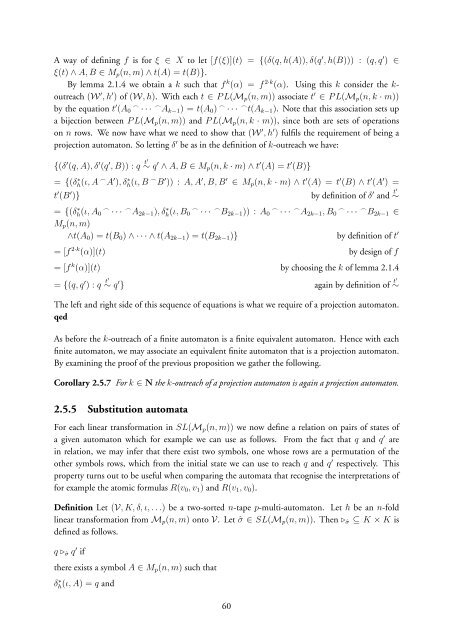On the methods of mechanical non-theorems (latest version)
On the methods of mechanical non-theorems (latest version)
On the methods of mechanical non-theorems (latest version)
You also want an ePaper? Increase the reach of your titles
YUMPU automatically turns print PDFs into web optimized ePapers that Google loves.
A way <strong>of</strong> defining f is for ξ ∈ X to let [f(ξ)](t) = {(δ(q, h(A)), δ(q ′ , h(B))) : (q, q ′ ) ∈<br />
ξ(t) ∧ A, B ∈ M p (n, m) ∧ t(A) = t(B)}.<br />
By lemma 2.1.4 we obtain a k such that f k (α) = f 2·k (α). Using this k consider <strong>the</strong> k-<br />
outreach (W ′ , h ′ ) <strong>of</strong> (W, h). With each t ∈ P L(M p (n, m)) associate t ′ ∈ P L(M p (n, k · m))<br />
by <strong>the</strong> equation t ′ (A 0 ⌢ · · · ⌢A k−1 ) = t(A 0 ) ⌢ · · · ⌢t(A k−1 ). Note that this association sets up<br />
a bijection between P L(M p (n, m)) and P L(M p (n, k · m)), since both are sets <strong>of</strong> operations<br />
on n rows. We now have what we need to show that (W ′ , h ′ ) fulfils <strong>the</strong> requirement <strong>of</strong> being a<br />
projection automaton. So letting δ ′ be as in <strong>the</strong> definition <strong>of</strong> k-outreach we have:<br />
{(δ ′ (q, A), δ ′ (q ′ , B)) : q ∼ t′<br />
q ′ ∧ A, B ∈ M p (n, k · m) ∧ t ′ (A) = t ′ (B)}<br />
= {(δ ∗ h(ι, A ⌢ A ′ ), δ ∗ h(ι, B ⌢ B ′ )) : A, A ′ , B, B ′ ∈ M p (n, k · m) ∧ t ′ (A) = t ′ (B) ∧ t ′ (A ′ ) =<br />
t ′ (B ′ )} by definition <strong>of</strong> δ ′ and ∼<br />
t′<br />
= {(δ ∗ h(ι, A 0 ⌢ · · · ⌢A 2k−1 ), δ ∗ h(ι, B 0 ⌢ · · · ⌢B 2k−1 )) : A 0 ⌢ · · · ⌢A 2k−1 , B 0 ⌢ · · · ⌢B 2k−1 ∈<br />
M p (n, m)<br />
∧t(A 0 ) = t(B 0 ) ∧ · · · ∧ t(A 2k−1 ) = t(B 2k−1 )} by definition <strong>of</strong> t ′<br />
= [f 2·k (α)](t) by design <strong>of</strong> f<br />
= [f k (α)](t) by choosing <strong>the</strong> k <strong>of</strong> lemma 2.1.4<br />
= {(q, q ′ ) : q ∼ t′<br />
q ′ } again by definition <strong>of</strong> ∼<br />
t′<br />
The left and right side <strong>of</strong> this sequence <strong>of</strong> equations is what we require <strong>of</strong> a projection automaton.<br />
qed<br />
As before <strong>the</strong> k-outreach <strong>of</strong> a finite automaton is a finite equivalent automaton. Hence with each<br />
finite automaton, we may associate an equivalent finite automaton that is a projection automaton.<br />
By examining <strong>the</strong> pro<strong>of</strong> <strong>of</strong> <strong>the</strong> previous proposition we ga<strong>the</strong>r <strong>the</strong> following.<br />
Corollary 2.5.7 For k ∈ N <strong>the</strong> k-outreach <strong>of</strong> a projection automaton is again a projection automaton.<br />
2.5.5 Substitution automata<br />
For each linear transformation in SL(M p (n, m)) we now define a relation on pairs <strong>of</strong> states <strong>of</strong><br />
a given automaton which for example we can use as follows. From <strong>the</strong> fact that q and q ′ are<br />
in relation, we may infer that <strong>the</strong>re exist two symbols, one whose rows are a permutation <strong>of</strong> <strong>the</strong><br />
o<strong>the</strong>r symbols rows, which from <strong>the</strong> initial state we can use to reach q and q ′ respectively. This<br />
property turns out to be useful when comparing <strong>the</strong> automata that recognise <strong>the</strong> interpretations <strong>of</strong><br />
for example <strong>the</strong> atomic formulas R(v 0 , v 1 ) and R(v 1 , v 0 ).<br />
Definition Let (V, K, δ, ι, . . .) be a two-sorted n-tape p-multi-automaton. Let h be an n-fold<br />
linear transformation from M p (n, m) onto V. Let ˆσ ∈ SL(M p (n, m)). Then ⊲ˆσ ⊆ K × K is<br />
defined as follows.<br />
q ⊲ˆσ q ′ if<br />
<strong>the</strong>re exists a symbol A ∈ M p (n, m) such that<br />
δ ∗ h(ι, A) = q and<br />
60
















